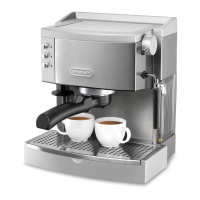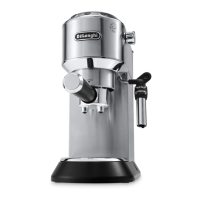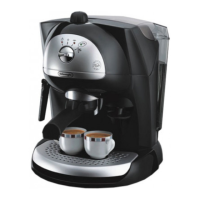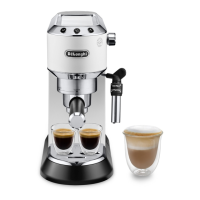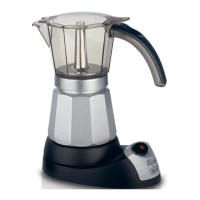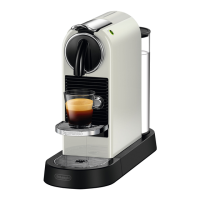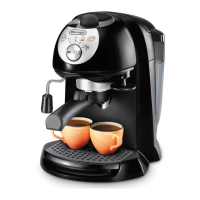clockwise direction. In order to ensure that the milk
froths correctly, always wait (between making one
cappuccino and the next) until the CAPPUCCINO
OK pilot light comes on.
TIP: to achieve a perfect cappuccino, the following
proportions are recommended: 1/3 coffee and 2/3
foamed milk.
• Once the last cappuccino has been prepared, before
turning off the coffee maker, lift the suction tube of
the tank above the level of any remaining milk (as
indicated in fig. 23), let the steam come out for a few
seconds, then close the knob with the tube thus
extracted. FOR HYGIENIC REASONS, IT IS
RECOMMENDED THAT THIS OPERATION ALWAYS
BE CARRIED OUT SO AS TO PREVENT THE MILK
FROM STAGNATING IN THE CIRCUITS OF THE
COFFEE MAKER.
•Lastly, to prevent the mild from solidifying, it is
necessary to wash the milk tank immediately, as
described below in the “Cleaning the milk foamer
and tank” section.
ATTENTION: the first time that the machine is used, it is
necessary to wash all the accessories and internal
circuits as follows:
1.For the espresso boiler: make at least five coffees
without using any ground coffee (following the
directions given in the HOW TO PREPARE
ESPRESSO COFFEE).
2.For the steam boiler: fill it with a water measuring
container, close the cap and press the
CAPPUCCINO button. After 5 minutes, turn the knob
and let steam come out until completely empty (this
should take about 15 minutes).
CLEANING AND MAINTENANCE
CLEANING THE MILK-FOAMER
The milk foamer must be cleaned immediately after
every use. Proceed as follows:
• Remove the milk tank by pressing the hook and
simultaneously pulling upwards. Wash it with warm
water. To facilitate the cleaning of the milk tank tube,
it is possible to use the tube brush provided.
• Remove the red-coloured foamer by pressing on the
clamp (A) and simultaneously pulling upwards (fig.
24). Remove the rubber mixer, wash and clean it
with hot water, especially the four holes shown in
figure 25 (use a needle to clean these). Make sure
that the hole marked by the B arrow is not plugged.
• Once clean, all the parts must be re-assembled in the
correct manner. In particular, make sure that the
rubber mixer is inserted all the way in and that the
red coloured foamer is inserted until a click is heard.
If this cleaning is not carried out after every use, the
milk foamer may not work properly, the milk may not
be aspirated or the milk may drip from the milk tank
tube.
CLEANING THE FILTER HOLDER FOR GROUND
COFFEE
About every 300 coffees, clean the filter holder for
ground coffee as follows:
• Remove the filter with the frother;
• Clean the inside of the filter holder. Never wash in a
dishwasher.
• Unscrew the cap of the frother (fig. 26) by rotating in
the direction indicated by the arrow on the cap.
• Remove the frother from the container by pushing it
from the cap end.
• Remove the gasket.
• Rinse all components and clean the metal filter
thoroughly in hot water using a brush (fig. 27). Make
sure the holes in the metal filter are not blocked. If
necessary, clean with a pin (see fig. 28).
• Replace the filter and gasket on the plastic disk as
shown in figure 29. Make sure to insert the pin on
the plastic disk into the hole in the gasket indicated
by the arrow in fig. 29.
• Replace the assembly into the steel filter container
(fig. 30), making sure the pin is inserted into the hole
in the support (see arrow in fig. 30).
• Finally, screw on the cap.
Failure to clean as described above invalidates the
guarantee.
CLEANING THE FILTER HOLDER FOR PODS (IF
SUPPLIED)
About every 300 coffees, clean the filter holder for
pods as follows:
• Push the filter holder button, remove the filter (fig.
31). Clean the inside of the filter holder. Never wash
in a dishwasher.
• Clean the filter thoroughly in hot water using a
brush. Make sure the holes in the metal filter are not
blocked. If necessary, clean with a pin (see fig. 28).
• Replace the filter.
Failure to clean as described above invalidates the
guarantee.
CLEANING THE ESPRESSO BOILER OUTLET
At least twice a year, the espresso boiler outlet must be
cleaned as follows:
• check that the coffee machine is not warm and the
plug is detached from the mains;
• using a screwdriver, unscrew the screw that holds the
outlet of the espresso boiler (fig. 32);
• Clean the boiler with a damp cloth (fig. 15);
15

